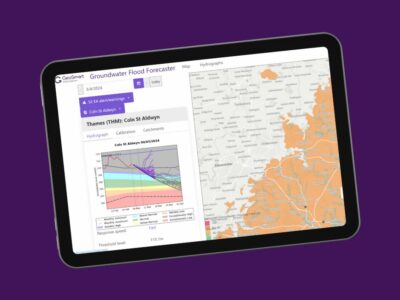Basement Groundwater Flood Risk: Key issue for London Planning Applications
Recent research by Newcastle University has revealed the dramatic increase in planning applications for basement developments in West London. But could these huge investments be affected by growing groundwater flooding risk in the future?
From 2008 to 2017, some 4,650 basements have been approved, creating ‘Iceberg homes’ up to 59 feet (18 metres) deep. These include 785 large basements at two storeys under the house, with a further 112 ‘mega basements’ – at three storeys or more. Many of these are often bigger than the houses they are built under.
Creating a basement in your home will only require planning permission in certain cases. Unless you are changing the look of the outside of the house or the building is listed, it is generally not needed.
So, digging straight down is attractive for those with the financial means to do so. In time, though, the capital invested could become seriously compromised by a hidden flood risk.
London’s hidden groundwater flood risk
We have cross matched the basement application locations from the Newcastle University research with our GW5 National Groundwater Flood Risk Map. For the Borough of Hammersmith and Fulham, we have identified some 30% of these applications are at risk of groundwater flooding.
The bedrock underlying the borough is predominantly London Clay. This is overlaid with superficial deposits of sand and gravel across the southern extent of the borough. The groundwater flood risk comes from permeable gravels along the historic floodplain of the River Thames.
After heavy rainfall, the water table within this gravel layer rises. Localised groundwater flooding can then occur in excavations and basements.
The London Borough of Hammersmith and Fulham’s 2017 Flood Risk Strategy highlights that the majority of the southern half of the borough is considered to be potentially at high risk of groundwater flooding.
The pressure for high value real estate continues to spread across the capital. Other parts of North and South East London overlie chalk. which is far more responsive to seasonal groundwater level variations. These fluctuations can be the order of tens of meters.
Could basements increase groundwater flood risk?
This begs the question: What is the cumulative impact of hundreds or thousands of basements over the next 100 years? How will they affect groundwater systems which have a finite capacity to store and transmit water?
Basements ‘sterilise’ or ’remove’ aquifer material, which normally store and conduct water, so these functions are lost. If these aquifers reduce over the coming decades, those that remain may become overloaded during winter periods. This could lead to higher groundwater levels and a greater risk of emergence.
Municipal storm water systems also have an increased risk of becoming overloaded during the winter. This could lead to leakage risks to existing properties and infrastructure, as well as structural impacts from heave.
Basement Flooding Risk: Understanding Groundwater
At a recent Flood and Coast event, William King of WSP highlighted that London authorities are increasingly looking at planning applications to consider basements and soakaways within 1km of the proposed basement.
They are more closely assessing local ground conditions and the infrastructure footprint. Key questions now centre around whether ‘aquifer’ materials are present and if so, how finite they are? Taking groundwater levels and permeability data available, notably in winter periods will become more important, as well as the presence of soakaways.
Basement Impact Assessments are therefore an important part of the structural calculations and should take a detailed look at the impact of groundwater on the development.
GeoSmart offers Basement Impact Assessments (BIA) as part of our FloodSmart range of reports. We assess the geology, the presence of aquifers and watercourses and consider the impact on surface water and local drainage, in the context of the local planning authority’s strategy.
The BIA enables architects and project surveyors to develop a better understanding of the Site and immediate surroundings, enabling them to plan ahead for potential risks and plans for mitigation.
For more information on our Basement Impact Assessments, contact us today on 01743 298 100 or email us at enquiries@geosmartinfo.co.uk



